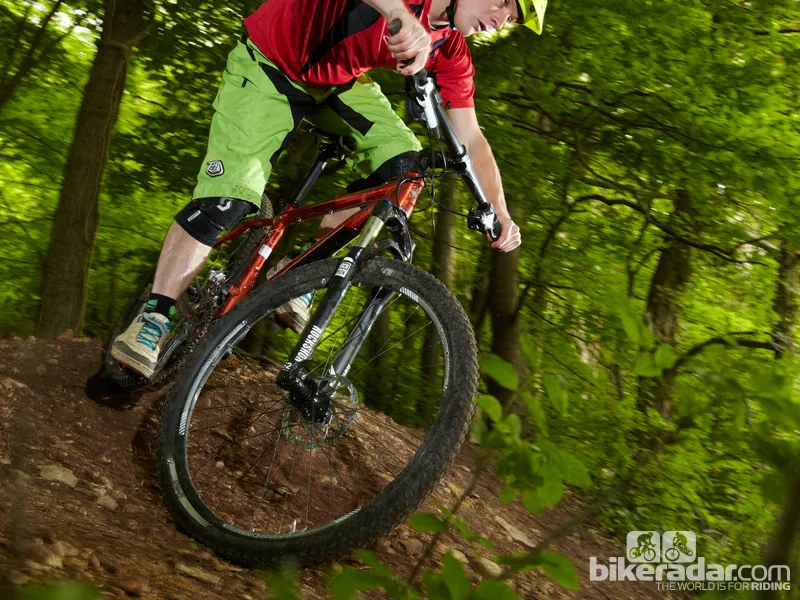Trek have been producing 29ers for far longer than any other major manufacturers (initially under the Gary Fisher brand name), but the Stache hardtails are a new singletrack blasting design.
Ride & handling: Light handling with great tracking and power response
It’s a tribute to the tyres and the frame design that the Trek consistently felt more eager to accelerate and attack climbs than its relative heft would suggest.
There’s more than enough stiffness through the frame to recruit every sinew from shoulders to soles of the feet to getting the wheels moving, and it responds significantly quicker if you go full gas. It puts a lot of torque and traction down on climbs and marshy ground, too, clearing with ease several test moorland sections that have stumped us for a while.
While it’s not light, the Recon fork is smooth enough and the extra 20mm of travel over most 29er hardtails makes a big difference in control and confidence on big drops, rocks and logs.
The fat carcass 29er tyres also roll over rough stuff really well for serious speed sustain once you’ve got them going. The rear wheel screens out more chatter compared to some smaller-wheeled bikes, too, although you definitely get more of a wallop off bigger stuff than with some.
The overall result is that you’ll still be surprised what the Stache can batter through (and at what speed) compared to a smaller-wheeled suspension bike. The G2 geometry also gives a distinctively light feel to the steering, so you have little trouble turning the big front wheel in sharply, even with a 90mm stem.
While it can feel nervous and fluttery at first, the long wheelbase means it’s still an impressively stable bike once you learn to trust it, and the low bottom bracket means you can really rip it through corners with wheels scrabbling as you search for the exit point.
The front comes up surprisingly easily for manualling over or off stuff too, encouraging much more dynamic riding than most big-wheelers and leaving a big grin on our faces after every ride.

Trek Stache 7
Frame & equipment: Good value kit but heavy steel-legged fork
The signature tapered E2 head tube and steeply sloped top tube give good crotch clearance despite the big wheels. Gear cabling is internal. The asymmetrically flared and offset, concave backed seat tube for wheel and direct-mount front mech clearance is a masterpiece of hydroforming.
A shaped outlet port for the Stealth seatpost hose and external guides offset the fact that the water bottle bosses stop you sliding the seatpost down a decent distance.
The press-fit bottom bracket also has ISCG mounts ready for a chain device upgrade but the clutch rear mech and big rubber chainstay protector keep the drivetrain pretty quiet anyway.
Tapered chainstays are mid-sized rather than massive but a 142x12mm rear axle gives maximum stiffness and security and the brakes sit on easily adjustable post rather than IS brake mounts too.
Unlike many 29ers, it even comes in an extra small size with a 15.5in (39.4cm) seat tube and 76cm standover. The translucent paint is very thin in some areas, such as inside the dropouts and rear brake mount and more obviously on the front mech mount. The metallic finish still got lots of love from onlookers though.
While most trail 29ers still stick with a 100mm (3.9in) travel fork to avoid jacking the front end too high, Trek have properly committed to increased control with a 120mm stroke fork. It comes with Gary Fisher’s custom G2 geometry between the 15mm axle and the tapered steerer too.
This cheap Recon has steel – rather than alloy – stanchions, though, so they’re not light and the rebound adjuster is a little plastic flag up inside the fork rather than a proper dial.
The RaceFace twin-ring cranks power a full suite of Shimano SLX, with no hidden Alivio or Deore as on some more expensive bikes. The Avid Elixir brakes are solid stoppers and all the Bontrager finishing equipment is well made, but we would prefer a shorter stem and lock-on grips to go with the 730mm bar. The Bontrager tyres are certainly grippy enough to cope with courageous corner speeds and angles, and the rims are tubeless-compatible if you get an upgrade kit.
As good value as the 7 is, the Fox-forked, lighter specced Stache 8 for £1,800/US$2,419.99 doesn’t half look tempting if you can dig deeper into your pockets.
This article was originally published in Mountain Biking UK magazine, available on Apple Newsstand and Zinio.

